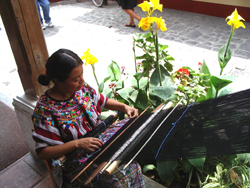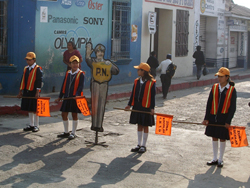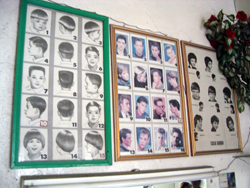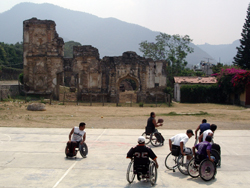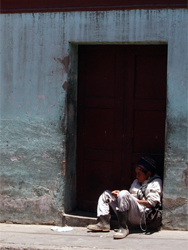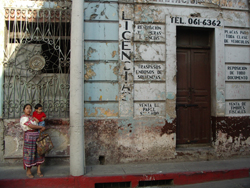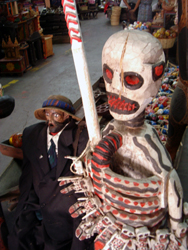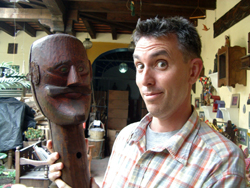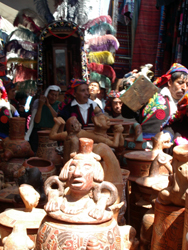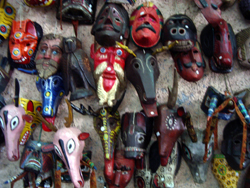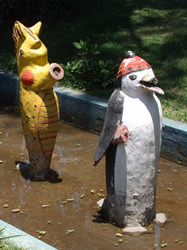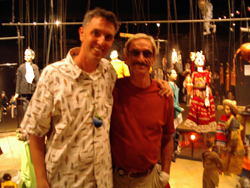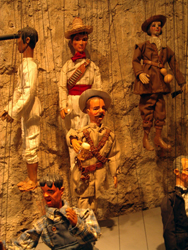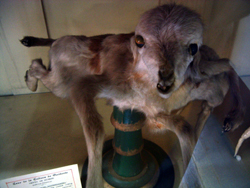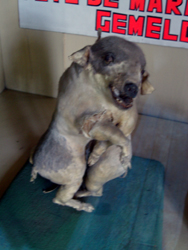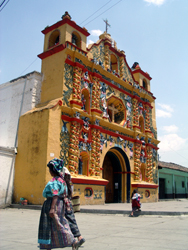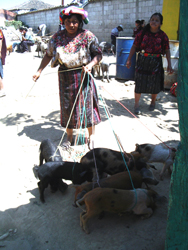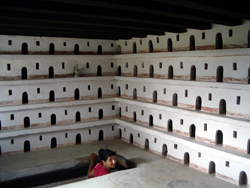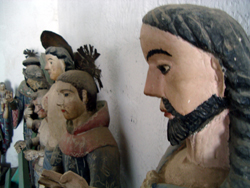Quetzals, Pretzels and Marimbas
Dispatch from Guatemala - April 2005
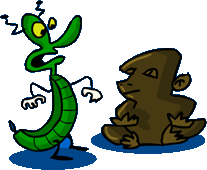
| Good Guatemalan Neighbors In
Chichicastenango Dine Excerpt
from “Chichicastenango” |
|
|
|
Life Begins at Forty In
his
1948 book “Roving South”, travel writer and general “bon
viveur” Willard Price describes Guatemala as “worth the
time” and “a spot without peer for charm and variety of
spectacle”. As Guatemala left me practically speechless, I couldn’t
find any finer words than that so I’ll ditto them. Guatemala is
the quintessential country of Latin America with an irresistible blend
of Colonial architecture, iridescent lakes, violent volcanoes, mild
mountainous climate, Mayan temples strangled by jungle growth, newspapers
full of news and interesting job opportunities, highly visible and irresistibly
photographic indigenous people and overall possibly the most vibrantly
colorful place on earth; a perfect place to turn forty years old. Forty
is a big number. Two score years and none. I spent the momentous day
in a Cuban restaurant sipping mojitos. |
| Charlie Chapin It’s
very easy to fall in love at first site with Guatemala in a way that
Honduras is an acquired taste or just perverse. Unlike Honduras you
can find twenty-seven volcanoes, much less trash, much more tourism,
traffic jams, National pride, Rigoberta Menchú (one of my personal
heroes) and a monument to the marimba. They sell fruit candy on the
busses instead of the word of god which leaves a much sweeter taste
in my mouth at least. There was no revolution in Guatemala but it did
have a brutal and bloody civil war that raged for 36 years (200,000
dead, probably well over 40,000 missing or “disappeared”
and a string of candidates for the Latin America’s Worst Dictator
award). The scars are still showing. These days the military (backed
by big business and the landowners) let the civilians run the government
so that they can get on with the serious business of running the country. |
|
|
|
Those
Magnificent Mayans
The
Mayans who apocryphally “failed to invent the wheel” did
of course invent astronomy, architecture and stone carving which excelled
even those in Egypt and Mesopotamia, the Milpa farming system, advanced
mathematics (they used base 20 system), the cross—this of course
long before Christians themselves were invented (the Mayan cross indicated
the “four elements” and there were four crosses that held
up the sky). Most important of all, the Mayans were the first to cultivate
the cacao bean, thus bringing chocolate to the world. They even used
stingray spines to pierce the penis in bloodletting ceremonies. How
cool is that? |
| Chocolate The Mayans called it “Ka-ka-w(a)”. The 16th century European “observers” in Guatemala saw Cacao used as money reporting that “the daily wage of a worker as forty cacao beans, ten could buy a rabbit while a slave may cost over one hundred”. They used the Theobroma (from the Greek meaning “food of the gods”) Cacao (from the Mayan word for the small under story tree). I’d never seen Cacao before. It’s an ugly fruit that when sliced smells nothing like chocolate and contains slimy pods. The magic all happens in the roasting and the sweetening. Here
is the Mayan symbol for chocolate: |
|
|
The Evil Saint Inside the ramshackle hut it was uncomfortably crowded and stiflingly hot. Toward the back of the room barely visible through the eye-stinging fumes of smoldering “copal” incense sat the life size effigy of San Simón known by most as Maximón or “Ry Laj Man” in K’iche”—the local Indigenous Mayan language. Devotees were shuffling into the dingy shack—filled to capacity with a kaleidoscope of brilliantly colored decorations and artifacts—to worship, give offerings and ask the deity for help. Requests run the gamut from successful crop harvests, cures for the sick, financial assistance and even misfortunes on enemies. |
But San Simón is no ordinary saint. He is often referred to as the evil or anti-saint. His origins come from a combination of the ancient Mayan Earth Lord “Ma’am” (grandfather), the biblical Judas and Pedro de Alvarado, the Spanish conquistador who came to Guatemala and of whom the Mayans had a reverential fear (even Cortes’ horse is venerated as a god in the northern jungle region of Petén). This syncretic Catholicism not only disguises the worshiping of false idols in the eyes of the church but in this way the indigenous Maya can register their needs with a Christian divinity as well as the Mayan doubling the chances of success. |
|
|
Nearly 60% of Guatemala’s people are classified as indigenous Mayan, however they speak 23 independent languages (K’iche’, Ma’am, Kaqchikel and Q’eqchi’ being the most prevalent) and numerous dialectical variations and combinations that villages just a few miles away may not be able to carry out a conversation. In this manner many communities have drawn themselves into a tortoise shell of tradition and have very little contact with the outside world. In fact 30% do not speak Spanish at all. The Catholic Priests sent to convert the population mostly gave up having achieved very limited success. The traditions proved too strong. |
Many churches contain decidedly non-catholic imagery and the Maya happily conduct their non-doctrinal ceremonies within the walls, burning incense for the deities of rain, fertility and corn and dressing statues in their traditional woven clothing. These days the Vatican—still unable to leave these people alone—at least tolerates these dogmatic modifications, unlike the evangelicals who use the strong-arm approach and have often been known to throw ancient Mayan idols over canyons (where the pieces are promptly retrieved, pieced together and the practice continues. San Simon remains unauthorized. |
|
|
|
Maximón symbolizes “chthonic male sexual power”. As an "opener of the way," his feast day falls at the onset of the fertile rainy season, but except for that day, his dark "trickster" aspect leads his devotees to carefully guard his visage from public view, for fear that his sexuality may run rampant. Yes, Guatemalan voodoo is great for tourism. Inside
the shrine, hundreds of multicolored incense candles burn under the
zinc roof which cracks as it expands under the hot sun. Sack loads of
freshly picked petals (mostly gladiolas in noticed), scatted onto the
melted wax floor add to the cacophony of scents and colors. Incense
and perfume dedicated to him is scented with the citrus odors of lemongrass,
citronella, and sweet orange. |
The air, as you can imagine, was a bright palette of odors. Feeling woozy on the fumes I watched as a man stepped forward to the figure. After whispering his request close to the idol’s ear, he took the short tasseled flag staff resting on the idols lap and taped himself, hoping for the lover, money, jobs or luck he asked for to materialize. The
affable To-jil, a “cholq’ij” (shaman or Mayan priest),
was on hand to help those who may not know exactly what to say to the
god. Because it was my birthday he told me about my “nagual”
or animal counterpart, “Pa-at” the monkey. Characteristically
that indicated I was a joker and pacifist. He told me to light a candle
which I could purchase from the store outside. Each color of beeswax
candle indicates a different request—yellow for health, red for
love, etc. |
|
|
The
deity is revered in various forms throughout the Guatemalan highlands.
In Nahualá near the Honduran border, Maximón appears as
a simple wooden box (with a bored hole for the offering of alcohol and
tobacco). Here in Zunil however, he takes a human form, something like
a mannequin wearing a wide-brimmed hat and boots, shoulders draped in
the traditional intricately woven scarves and rather bizarrely sporting
cheap wrap around sunglasses. A small opening in the lips allows for
Payaso brand cigarettes to be smoked which are administered by an assistant.
For drinking, the effigy is elegantly tipped back on a carefully constructed
hinged metal frame and the rum is poured into the mouth from a delicate
ceramic jug and collected in a container underneath (later to be consumed
by the “cofradía” who cares for and hosts the idol).
I was told his favorite liquor is the smooth Venado Rum but he often
has to settle for the cheaper Quetzalteca cane alcohol. Each year during
the annual San Simón festival he is moved to a new home. |
In Chichicastenango they have a famous market on Thursday and Sunday. Day trippers converge on this otherwise tranquil little town in little minibuses to buy souvenirs although the real spectacle is watching the indigenous Maya arrive like ants carting huge bundles of wares, then setting up their stalls the night before and dismantling the chaos after. “Chichi” also tops my top ten Guatemalan destinations because of it’s bizarre Central Park which sports a fountain of animal figures including a turtle wearing a top hat. Not many places can beat that for entertainment. |
|
|
|
It's All in the Wrist Action Dr.
Alberto Mejía Barón, a.k.a. “Alfin” is the
Mexican Gerry Anderson and he’s been making puppets for over fifty
years. Right now he is looking for a permanent place to exhibit his
wonderful creations and our paths crossed in Antigua. It’s not
just the quality of his puppets that make him one of the best in the
world but his choice of subject which ranges from Posada’s Day
of the Dead, Tropicana dancers from Havana, Alice in Wonderland, Dr.
Jeckle & Mr. Hyde, Frida Kahla, Cantínflas and the Mexican
Revolution. He’s also a spectacularly interesting man and truly
inspirational. |
Kleppermaniac In a village near Quetzaltenango, there was a shrine [Guatemala is big in the shrine business) to a legendry [name of International Development Organization withheld by request] volunteer who worked in the same site for 25 years. That has to be some sort of record as usually service lasts a mere two years. This volunteer, Janet Klepper from Portland, OR, started out in 1975 aged 54. She became fluent in the local indigenous Mayan language and set up several clothing and fabric cooperatives which are still functioning today. Sadly she died a few years ago but everyone in her village remembers their “gringa”. |
|
|
|
Xela Quetzeltenango
is a bohemian town. It is Guatemala’s second city and is more
commonly known as “Xela”. It also, happily enough, hosts
the Oddest Museum in Guatemala. Where else can you find a four month
old human fetus, a room dedicated to marimba orchestras, an eight-legged
calf, a huge collection of vintage beer bottles, a monument to the Liberal
revolution of 1871, a human brain and a Siamese puppy fetus displayed
next to some of the worst taxidermy you have ever seen. I had to return
to the museum three times. |
Xela was the first Guatemalan province to elect an Indigenous mayor and is actually more European in appearance than its colonial counterparts. It boasts several amazing restaurants, rep cinemas, funky bookstores and myriad pokey cafes selling deliciously rich—and almost undrinkable—chocolate drinks. They even sell fresh pretzels. Also, their local soccer team is called the “Super Goats” and it’s hard not to like that. You
can make all sorts of little day trips from Xela. Just pack your sandwiches
and a thermos flask and leap on one of the many flamboyantly decorated
busses that leaves from one of the myriad marketplaces. One such destination
is San Andrés Xecul which has a clown colored-church which is
probably already the new Pope's worst nightmare. |
|
|
Meanwhile, back in Zacapa As frequently happens, our little town is blighted with short periods without water, electricity and Internet (our only means of communicating with the outside world which runs on a separate battery system). Although we are often without one or two, we are rarely are we denied the use of all three at the same time. However, due to the seemingly endless construction of a new road into town we are frequently beset with the uncomfortable condition of having no essential utilities simultaneously. In
rural Honduras where potable water and modern technology are recent
inventions there is always a way for life to continue relatively normally.
Cooking without electricity is done on an simple old style “fogón”
oven. In our house this monstrous brick and clay contraption is mercifully
situated outside but in many houses the kitchen is filled with the acrid
smoke causing Honduras to have one of the highest rates of asthma in
the world. |
One recent morning I began lighting the oven to prepare breakfast when our neighbor, the seemly forever homebound Doña Pineda appeared. What our neighbor has in friendliness is excelled only by her curiosity. As I began lighting the fire she immediately accosted me and began casting accusations at my methodology. There immediately began a fire-lighting conflict which pitted the British Boy Scout method circa 1976 verses the Honduran “campesina” method circa 1937. The length and thickness of the kindling that should be used seemed to be the biggest discrepancy although even the rolled up balls of newspaper I used causes looks of astonishment. When I produced an automatic fire lighter she seemed a little intimidated but still managed to explain that using matches was superior. |
|
|
It went from bad to worse. As I prepared oatmeal and coffee I kept returning to find pots had been moved and ingredients had been added. Additional sticks would appear every time I turned my back. My espresso pot was mocked mercifully but produced what I took as silent awe as the delicious aromatic freshly brewed Honduran coffee fumes drifted across the wall. Thankfully, as often happens. Just as we sat down to eat the power returned. |
Spare the Air As I write this 2500 fires are burning in Honduras, most of them illegally started by farmers who are setting their old crops afire in order to add nitrate to the soil and save themselves the labor involved in cleaning the land. As a consequence a cloud of smog has descended on the country. Combined with the seasonal heat it makes for a miserable time. Planes have been unable to land for nine consecutive days (except mysteriously at the US military base at Palmerola). Visibility is sometimes down to about 20 feet and just to be outside involves choking, sneezing and irritated stinging eyes. We await the rains, due any day now which should bring a brief respite to ozone and the repertory infections. Hasta
la proxima... |
|

Previous dispatch | Next dispatch
©
J. Lemon / Lemonworld 2005. All rights reserved. This
web site is not an official publication of the Peace Corps or the U.S.
Government. The contents of this Web site reflect the personal opinions
and observations of the individual(s) contributor(s) and do not reflect
any position of the U.S. Government or the Peace Corps. |
